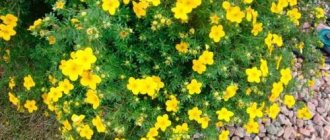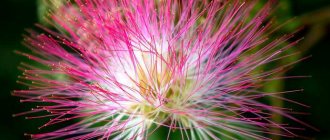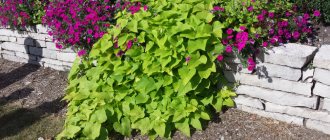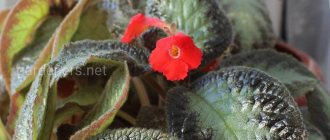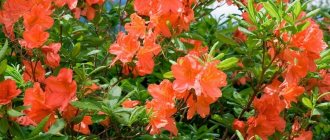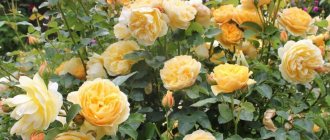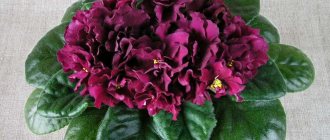Varieties of petunias with long flexible shoots are called ampelous. The stems can grow up to one and a half meters, they are completely covered with flowers of different sizes and colors. We have made a selection of the best varieties of ampelous petunia with photos and descriptions.
This variety of petunia is used to decorate fences and walls of buildings, placing flowers in hanging containers. Petunia looks beautiful in a flowerpot on the balcony, in a flowerpot on a high leg. Sometimes the plant is placed in open ground, allowing the stems to grow in a continuous flowering carpet.
Flowers of this variety are unpretentious and do not require special care, with the exception of slight pruning or pinching of shoots that thicken the bush.
You may be interested in how ampelous petunia differs from cascade petunia, as well as the features of their cultivation. Read
Types and varieties
Depending on the design wishes, the buyer can choose from seeds of bush, ampelous, low-growing, multi-flowered, double and fantasy varieties. A special group consists of vegetative petunias. The peculiarity of plants of this type is that they can be propagated by cuttings.
The world of petunias is represented by many species and varieties
Depending on the design wishes, the buyer can choose from seeds of bush, ampelous, low-growing, multi-flowered, double and fantasy varieties. A special group consists of vegetative petunias. The peculiarity of plants of this type is that they can be propagated by cuttings.
How to choose petunias. Adviсe.
The varieties are varied. But from them you can make a choice in favor of the variety you love based on its description. Petunias are suitable for every garden area. Small-flowered plants can be planted in flower beds and borders; ampelous petunias are suitable for alpine slides or containers.
The choice of petunias is now great. I don't want to choose. Beginners are advised to purchase petunias that are immune to diseases and resistant to bad weather.
Large-flowered varieties are demanding in terms of cultivation and care. They are afraid of rain and wind, which damage flowers and foliage. When cold weather and rain sets in, petunias stop blooming.
The most popular varieties of ampelous petunias
Determining recognized favorites among ampelous petunias is not so easy due to their diversity. Listed below are the most common varieties of ampelous petunias, which have received recognition from gardeners around the world.
1) The group of varieties of hanging petunias “Easy Wave” is distinguished by its unpretentious character and variety of colors. Sometimes plants of this variety are classified as semi-ampeloid varieties because of the lush flower cap that crowns the vase or pot from which shoots strewn with flowers hang.
“Easy Wave” looks equally good in floor and hanging flower pots, and is sometimes grown in open flower beds and even in beds in the front garden. The shoots of this petunia variety can grow up to 1 m and during the flowering period are completely hidden under bright flowers. As for care, to successfully grow Easy Wave you will need quite spacious containers with a volume of at least 8 liters. In addition, these petunias are sensitive to lighting conditions, so if there is a lack of sunlight, it is necessary to take care of sources of artificial light.
Additional lighting will allow “Easy Wave” to bloom profusely throughout the season, until the first frost arrives. A related group of varieties, Shock Wave, is represented by luxurious double petunias, whose flowers look spectacular against the background of emerald foliage.
Plants of these varieties are most often grown indoors. Another close relative of Easy Wave and Shock Wave is the Wave Purple Classic variety. It is characterized by early and persistent flowering throughout the season. In mild autumn conditions, this variety can bloom until early October. Shoots of "Wave Purple Classic" quickly grow up to 1 m.
2) Among ampelous petunias, surfinias are very popular - plants with very powerful shoots that can grow up to 2 m, which brings them closer to cascading petunias. Thanks to this feature, surfinia petunias can withstand bad weather and successfully recover even after blows from storm winds.
The crown height of these plants can reach 70 cm. Thanks to their resistance to unfavorable conditions, surfinia will feel good not only in the sun, but also in a slightly shaded corner. Some gardeners grow them in garden beds and open flower beds.
The color range of surfinias is quite extensive and includes various shades of red, pink, white, purple and blue. “Table Yellow” is a relatively new variety of this group of petunias, which has already managed to win the sympathy of flower growers.
3) Another popular group of varieties of ampelous petunias is Avalanche. Their flower petals are typically red, orange, pink, white or blue.
4) Surfinia also includes another varietal group of ampelous petunias called “Velvet”. The flowers of this group are characterized by a velvety coating of the petals. Surfinia "Velvet" is very attractive to pollinating insects and is known for its honey-bearing qualities.
Among them, the Black Velvet petunia stands out for its unusual color - the diameter of its velvet flowers of a very dark shade can reach 8 cm. The height of the lush crown is 25-35 cm. The Purple Velvet variety boasts quite long for hanging petunias with shoots that can grow up to 1 m in a short period of time.
5) Hybrid varieties “Opera Supreme” belong to small-flowered ampelous petunias. The advantage of this variety is its unpretentiousness: it does not require additional lighting for abundant flowering. In indoor conditions, Opera Supreme can bloom almost all year round.
6) Ampelous petunias of the Explorer series varieties demonstrate a wide range of colors, impressive even for petunias. The strong and flexible shoots of these plants grow up to 1.5 m and safely withstand storm winds, and the waxy coating on the leaves makes them insensitive to rainwater.
7) The variety “Purple Waterfall” (Cascade Purple) is classified as semi-ampeloid petunias, which look equally impressive both in hanging and in floor planters, containers, and flower beds. "Purple Waterfall" is resistant to adverse weather conditions and heat. Another advantage of this variety of petunias is the early sowing and flowering period. You can start planting at the end of winter; it is enough to provide the seedlings with additional lighting.
Another large-flowered variety of ampelous petunias is called “Rapunzel”. Its shoots, growing up to 80 cm, during the flowering period are covered with flowers with a diameter of 8 cm. This variety tolerates drought and heat well, so it is optimal for gardeners who do not have the opportunity to regularly water their plants.
9) Early flowering is characteristic of the “Success Violet” variety. The height of the bushes of these petunias can reach 35 cm, and the length of the shoots ranges from 70 to 90 cm.
Features of cultivation
Growing ampelous petunia is not difficult. This is an unpretentious plant that requires minimal care.
Many novice gardeners think that all varieties of petunias have similar rules of agricultural technology.
In fact, in order to grow ampelous petunia, it is important to take into account several nuances:
- Distance between plants. It should not be less than 30 cm, while a gap of 20 cm is left between bush varieties.
- Lighting. Ampelous petunia is especially demanding in terms of lighting. If it is planted in a shaded area, flowering will be poor.
- Formation. The ampelous variety requires more attention to formation than bush petunias. Not only do they pinch off the main stem, but also cut off the side shoots. In this case, parts of the stems are cut off, since pinching is ineffective.
- Trimming seed pods. Unlike cascading petunia, the ampelous variety requires pruning of faded fruits and seed pods. Otherwise, few flowers will form.
Classification of ampelous petunias
In the huge number of existing hybrid varieties and entire varietal groups, petunias are primarily distinguished by several parameters that characterize flowers:
| Parameter | Options |
| Flower shape |
|
| Flower sizes |
|
| Coloring of corolla and petals |
|
Ampelous petunia Easy Wave (Easy Wave)
This variety is one of the giants of the ampelous variety. Characteristics:
shoot length – 1 m;
long flowering until frost;
forms a dome-shaped or spherical crown;
flowers yellow, blue, red, purple, pink.
The variety is suitable for growing in hanging pots and open ground. All colors begin to bloom at the same time, so you can make compositions with numerous shades.
Ampelous petunia Velvet (Velvet)
A late-flowering variety of ampelous petunia, it attracts attention due to its abundant flowering and lush growth. Main characteristics:
shoot length – 1 m;
flower diameter 7 cm;
petals from pink to purple tones, velvety;
the tube is contrasting, yellow and black.
Petunia is an excellent honey plant. She attracts bees. There is high resistance to disease.
Ampelous petunia Opera Supreme (Opera Supreme)
The main features of this variety:
shoot length – 1 m;
flowers 6 cm in diameter, funnel-shaped;
color white, pink, lilac, light blue, dark blue.
The shoots branch well, so you can give them not only a hanging shape, but also a spherical one. Ampelous petunias are distinguished by long-term flowering, subject to the application of fertilizers and the removal of wilted shoots and flowers.
Large-flowered
Among the large-flowered petunias, “Waterfall Blue F1” stands out. The culture grows quickly and blooms early. Then flowering does not stop until frost begins. The variety can be used in hanging gardening. Even in very bad weather, the bush retains its basic qualities. Judging by reviews from flower growers, “Waterfall” performs best on borders, loggias and balconies.
The “Limbo” variety, along with the large-flowered variety, also belongs to the dwarf hybrid group. When growing such petunia in a room, its growth can reach 0.15 m. When cultivated in open ground - up to 0.2 m.
The same diameter (0.2 m) is typical for purple flowers. Interesting: “Limbo” can have multi-colored inflorescences on each bush. Of the more traditional varieties, Alderman deserves attention. This is an annual plant, stretching up to a maximum of 0.3 m. Shoots hang from a wide, dense bush.
An attractive feature of 'Alderman' is its large blue-purple flowers. They retain their attractiveness for 3 or 4 months. Group landing predominates. Caring for Alderman is relatively simple. Petunia can even be propagated by seeds.
Important: when growing seedlings you will have to put in a lot of effort. But, having successfully obtained adult plants of this variety, it is easy to decorate flower beds, balconies or simple grassy lawns. The “Prism” variety also does not require too complicated care in adulthood. This plant gives excellent results in all corners of the world - and is popular everywhere.
Important: despite the simplicity of the care rules, they cannot be ignored.
The slightest deviation can lead to bad consequences. Variety "Sofia F1" is a hybrid type that produces elegant flowers. The bushes branch strongly and bloom for a long time. They produce light pink flowers with juicy veins of carmine pink color. Bud diameter is 0.07-0.09 m.
The culture loves warmth and light and tolerates dry periods quite well. “Sofia” is planted both in groups and in large tracts. The plant is recommended for landscaping the balcony. By pinching the top early, you can increase the splendor of flowering.
“Floribunda” is not a variety, but a whole group that occupies transitional places from multi-flowered to large-flowered varieties of petunia.
The Sonya F1 series of hybrids falls into the same category. The height of the plants reaches 0.25 m. There are 11 hybrids, which can differ in the most unusual and expressive colors. The Celebrity F1 series is famous for its excellent resistance to heat and precipitation. In addition, representatives of the group are colored very interestingly, containing contrastingly colored veins.
Among the Celebrity petunias there are already over 30 different colors. Large-flowered plants can also be of the double type. This is typical for Madness hybrids. Some specimens develop white petals. The series is characterized by numerous flowers with a diameter of 0.07 m.
Multifloral
Of the multi-flowered group of petunias, Glafira is very popular. The variety forms a relatively modest bush. Its maximum height is 0.3 m. And in some cases only 0.2 m. But flowering begins in May (provided that the seeds are sown early).
“Glafira” is often used when you need to decorate a patio or covered terrace. However, it will look good on an ordinary window sill. The diameter of the flowers will be 0.045-0.065 m. Flowering does not stop throughout the season. Another positive feature is that “Glafira” survives short dry moments well.
The “Flame” variety is not named so in vain. When it blooms, it seems that the bush is covered with frozen fire tongues. The plant loves light and can tolerate short droughts. Flowering begins in June and ends only in September. The bush reaches 0.3 m and is quite dense.
Any nutritious soil is suitable for “Flame”. It is recommended to plant seedlings in May.
“Cherry Crystal” is an annual plant with a height of 0.3 m and a flower diameter of 0.07 m. When flowering, this mixture of petunias is covered with buds so densely that it is difficult to see the remaining parts. At the same time, extraordinary harmonious coloring is guaranteed.
The use of the Berenika variety also opens up excellent prospects. Petunia of this variety is characterized by relatively low growth. The annual is highly branched and creeping. It is often used for flowerbed planting, ridges, and large arrays of flowering plants. But you can use this petunia to decorate balconies and in the yard in a hanging basket.
Single flowers of "Berenice" resemble a funnel. Their diameter ranges from 0.05 to 0.07 m. Both stems and foliage are covered with a fluffy layer of hairs.
The Snow Globe variety achieves excellent performance only with the right choice of seeds.
If they take root well, then a fluffy and pleasant-looking bush will definitely appear.
Small-flowered
The Latin name for small-flowered petunias - milliflora - has long been included in gardening catalogs. All such plants are annuals whose stems grow straight. Height no more than 0.25 m. Small buds look like a funnel or a bell. The size of flowers ranges from 0.025 to 0.04 m.
“Pink F1” is distinguished by abundant branching. Plants develop flexible, powerfully developing side shoots. The flowers will delight people until the frost begins. They are made up of simple petals. “Yellow Duckling F1” is very close to “Pink” (both in the length of the shoots, and in growth, and in flowering).
The variety gives excellent decorative results:
- in open ground;
- in a flowerpot;
- in a hanging basket.
Application in landscape design
With the help of hanging petunias, you will be able to create the most unusual compositions and bring your fantasies to life. After all, this plant takes root well both in the garden and on the balcony.
Flowers in pots are hung near the entrance to a house or gazebo, placed around the site, and hung on trees. The hanging petunia on poles looks interesting, imitating a flowering tree.
In open ground, the plant is used to create alpine slides. The flower looks beautiful as a frame for a flower bed.
Choosing a place for a plant
For petunias, it is necessary to select well-lit areas protected from the wind. The delicate petals of the plant cannot withstand gusts of wind and quickly wither. The flower will be comfortable in a flower bed located near the wall of the building. Petunia is often planted at the foot of large perennials; the plants do not interfere with each other, and protection from the wind will not hurt for petunia.
The flower has become widespread as a potted crop. The plant feels comfortable in the limited space of the pot. Flowerpots or pots with petunias are displayed on balconies, terraces, and they decorate the walls of buildings and window sills.
Petunia in a flowerpot
What time to plant
Loamy or sandy loamy fertile soil is suitable for growing petunias, and it will be very good if humus or compost is added to it before planting the plants. Fertilizing the soil with manure is not recommended because it can cause fungal diseases. For planting, you should choose a well-lit, open area. It is necessary to plant seedlings in the spring when there is no threat of return frosts (usually from mid to late May). Planting should be done in the evening or on a rainy day.
Fertilizer
Another important nuance of growing petunias is fertilizing. Intense flowering and growth of petunias require a constant supply of nutrients. This is one of the few ornamental plants that is in dire need of fertilizer.
Due to the special requirements for the amount of individual nutrients, including potassium and iron, it is better to use a special multi-component liquid fertilizer intended for petunias, surfinium. The fertilizer should be rich in potassium and iron, poor in nitrogen. It is worth recommending special fertilizers for petunias, which contain an additional dose of iron and help avoid the typical plant symptoms of deficiency of this element.
The dose and timing are established based on the information on the drug packaging, since excessive fertilizer can harm the plants more than help.
There is no such danger when using vermicompost - an organic fertilizer. However, although this is a very good preparation, it is not enough for plants that flower profusely. Regular fertilization begins 3-4 weeks after planting and continues throughout the growing season.
Reviews from flower growers
Evgenia, 35 years old, Kostroma
I love petunias, and especially the Wave series. I plant both in flowerpots and in open ground, the flowerbed turns out to be a real carpet of flowers, they bloom very profusely! True, pinching with this in mind sometimes takes almost an hour, but that’s okay, it even somehow calms you down. The flowers tolerate rain and wind well. I feed the petunias that are in the pot, and the ones that are in the flower bed, in my opinion, do well without it.
Maria, 28 years old, Ufa
Last year I planted Parple Velvet. The only thing I didn’t like was that the manufacturer did not cover the seeds with a shell; without this they are very tiny, it was difficult even to pick them up with tweezers. I planted it in March, there was no point in earlier in our region, everything came up. I transplanted them into flowerpots in June, they grew quickly, and branched even without pinching. The view from the street was amazing, I even wanted to stand in front of my own window longer! Although the flowers are relatively small, there are so many of them that in some places the greenery underneath them was not visible. We endured a slight frost with fortitude and didn’t even get sick.
Nadezhda, 44 years old, Omsk
My favorite is Explorer. I usually buy seedlings; by the way, it’s interesting that the shoots immediately grow wider than upward. I keep it on the balcony, but I try to fix the pots higher, above my head, otherwise you won’t really admire this beauty. Our area is windy, but the lashes are strong and have never broken off yet. They require a lot of land, the year before last I planted two flowers in one flower pot, then replanted them, and they grew at triple the speed.
Care
Petunia needs careful care, only then will it show itself in all its glory. The soil in the flower garden is kept free of weeds and is regularly loosened shallowly.
Water petunia only with water heated in the sun, strictly at the root, twice a week. In hot weather, flowering plants require daily evening watering.
Flower feeding is applied twice a month in the form of liquid solutions. Immediately after planting the seedlings, the main element in the fertilizer is nitrogen. It is responsible for the active growth of green mass.
During the period of budding and flowering, petunias are fed with a predominance of phosphorus and potassium. It is convenient to use ready-made complexes for petunias or universal flower fertilizers (Pokon, Kemira Lux, Raduga, Fertika).
To preserve the decorative appearance of petunia bushes, faded buds are removed from the plant. Ampelous and cascading forms of plants can be formed by cutting, giving them the desired shape.
Transplanting seedlings for permanent residence
Petunia is resistant to weather changes, including low air temperatures.
Petunia looks beautiful in a hanging pot
However, it is recommended to replant plants at a time when the threat of frost has passed, otherwise low night temperatures will have a negative impact on the further development of seedlings.
The best time for transplantation is the end of May - the first days of June.
Selection of fertilizers for feeding
Full development of plants is impossible without the addition of additional fertilizer. During the growing season, petunias need to be fed, because growth and lush flowering depend on the availability of nutrients.
If there are enough of them, petunia bushes will bloom profusely right up to frost.
You need to choose specialized fertilizers
It is advisable to choose complex fertilizers so that you do not have to calculate the concentration of each of them. Petunias need more potassium supplements, so when choosing fertilizers, it is advisable to read the composition and see that the potassium content is high.
When growing at home, it is better to use liquid fertilizers. The first watering is carried out a week after transplanting the plants. Petunias need to be fertilized once every 2 weeks.
Caring for flowering plants
If petunias grow in a flowerbed, you must constantly loosen the soil around the plants and water them. After flowering, it is necessary to pick off the dried inflorescences so that the plants do not waste energy setting seeds.
Growing ampelous petunias in hanging pots: the beauty and compactness of the bush depend on the correct pinching of the tops of the plants
In addition, even mature, flowering plants need to be pinched. Removing the tops promotes tillering of petunias.
Due to the fact that petunia adapts to living conditions and is unpretentious to climatic conditions and soil composition, it has gained universal popularity. Gardeners note that caring for petunia is not difficult, although many amateur gardeners note the capriciousness of the plant, however, the beauty of the blooming flowers allows you to forget about the difficulties encountered during cultivation.
Your opinion and assessment of this material is very important to us. If you do not agree with these ratings, leave your rating in the comments with the reasoning for your choice. Thank you for your participation. Your opinion will be useful to other users.
Mr. Summer Resident advises: how to preserve a petunia bush in winter
It is not recommended to leave garden crops in the ground during the cold season. The plant is removed from the soil in mid-October. The next step is to eliminate all shoots. The pot with the transplanted petunia is placed in a cool room. Watering should be rare and moderate. Overwatering will cause rotting of the root system. In February, the container should be brought into a warm room. The resulting cuttings can subsequently be used for propagation.
Today, these hybrids are planted as balcony and potted crops. Bright annuals are often grown in garden plots. The popularity of petunia is due to its decorativeness and unpretentiousness. Additional benefits include a long flowering period. Petunia harmonizes well with other garden crops.
Subtleties of care and rules for growing perennial petunias
Perennial petunia is grown according to fairly simple rules. The main thing here is to properly prepare the plant for the cold season. This will ensure good, abundant flowering next season. You need to transfer flowers to heated rooms before the first night frosts. It is not difficult to create optimal conditions for the plant. He only needs bright lighting and a slightly lower temperature. Since the crop continues to bloom after transfer, do not forget about the need for watering.
These types of vegetative petunia should go into a dormant state. During this period, the plant’s soil is irrigated rarely and quite sparingly. But this must be done to support the development of the rhizome. Full flower care is resumed only when daylight hours increase. In the spring you need to gradually increase watering. The substrate for petunias should always be slightly moistened. Caring for your perennial in this way will allow it to quickly grow. When the first young leaves are formed, you can fertilize.
Diseases and pests
In our climate, petunias will not survive the winter, so protection for the fall is not needed - faded, drying plants can be thrown away. Unfortunately, the short life of a petunia comes with many other problems.
Petunias are not completely resistant to diseases and pests. They are struck by:
- aphids - insects that damage plants and transmit viruses;
- viruses;
- fungal diseases.
The most common viral diseases affecting petunia are:
- cucumber mosaic virus;
- tobacco mosaic virus;
- potato mosaic.
Unfortunately, nothing can be done with diseased samples - they must be quickly destroyed.
Cultivation errors contribute to the emergence of diseases and pests. In the case of pests, soil-based insecticides are used for control. Before fungal diseases appear, it is better to carry out prevention, because spraying is not very effective with a large mass of flowers and leaves. Infected plants can be treated with specialized drugs.
A common disease is the so-called white mold - a white coating on petunia leaves. The flower dies literally before our eyes. Spraying is carried out 2 times per season.
It is important to carry out the following preventive measures:
- remove fading inflorescences;
- put antifungal sticks in pots
- pour out excess water from the stands;
- apply appropriate fertilizer;
- avoid irrigating plant leaves during watering;
- ensure that there are no other diseased plants in the immediate vicinity of the petunia;
- arrangement of flowers under the roof - rainy weather can provoke the development of fungi and physically destroy flowers and leaves;
- It is advisable to plant petunias in white boxes - dark ones attract heat, the roots overheat.
Reproduction
Petunia is most often propagated by seeds. You can collect them from your flowers yourself (they have time to ripen in the middle zone) or buy them in a store.
Petunia seeds are very small, sometimes seed producers process them. Dried seeds are easier to sow; their coating of fertilizer allows the plant to receive nutrition as soon as the sprout appears.
To enjoy flowering longer, petunia is sown early - at the end of January or February. The soil is prepared from a mixture of peat, sand, and turf humus. Petunia can be sown in boxes or directly in separate pots, peat tablets.
Important! The seeds are laid out on the surface of the soil without covering them with soil!
Some gardeners practice sowing petunias in snow, sowing seeds on a layer of snow laid on seedling soil. This method helps to distribute the seeds evenly (dark seeds are clearly visible on white snow). The snow, gradually melting, feeds the seeds with useful melt water.
Seeds
Before germination, the crops are kept covered with film or glass in a warm place. After the emergence of seedlings, the shelter is removed gradually, accustoming the seedlings to fresh air.
Caring for seedlings consists of watering, loosening and picking in the phase of 4 - 5 true leaves. Until the beginning of April, planting petunias must be supplemented with light, extending the daylight hours to 11 hours. During the growing of seedlings, they are fed twice:
- a week after germination with nitrogen fertilizer;
- after picking - potassium.
Petunia is planted in the ground only when the weather is warm. Lowering the temperature to 0 degrees can destroy a delicate plant.
The distance between petunia bushes is maintained at least 30 cm for compact forms, and at least 60 cm for large ones. There is a vegetative way to propagate petunia - cuttings. It is used for varieties that do not retain their qualities when propagated by seed.
Seedling
The mother plant is placed in a spacious pot in the fall and stored in a bright and cool (temperature +14 +18 degrees) room. Petunia is not fed and watered not often.
By March, the bush is brought into a warm place, watering is increased, and nitrogen fertilizing is applied. When stepsons actively grow on a plant, they are cut off and rooted. The cuttings are dusted with Kornevin or Heteroauxin, and the branches are placed in damp sand or vermiculite. The top of the container with cuttings is covered with a greenhouse.
The cuttings are regularly ventilated or the soil is watered moderately. After 2 - 3 weeks, a good root beard will form on the seedlings. Seedlings from cuttings are planted in a flowerbed in the same way as plants obtained from seeds.
Petunia propagation by cuttings
Propagation by cuttings is suitable only for double and ampelous petunias, as well as for all cultivar groups of mini-petunias (calibrachoa). Terry varieties can be propagated by cuttings in the last weeks of winter, the first weeks in spring, while mini-petunias and ampelous ones can be propagated all year round, but for this they will need additional illumination with fluorescent lamps, as well as warmth (from 21 to 24 degrees).
Cut the apical cuttings, which should have 4 to 6 leaf blades. Tear off all the leaves except the top two. The remaining leaves should be shortened by ½ part. The cuttings need to be planted for rooting in the same soil mixture that is used for seedlings. However, in this case, the surface of the substrate should be covered with a layer of perlite or sand 20–25 mm thick, which must be spilled with a fungicide solution. A distance of 15–20 mm must be maintained between the cuttings, and the container is covered with glass on top.
It is unnecessary to use growth stimulating agents (for example, Heteroauxin), because freshly cut cuttings take root well, but you should not delay planting them. The substrate in the greenhouse should be slightly damp at all times; for this, the petunia needs to be moistened twice a day with a spray bottle. However, it should be noted that excessive dampness contributes to the development of “blackleg” or mold. Terry and ampelous petunia will take root completely after approximately 7 days, and mini-petunia after 14 days.
After the roots reach 10–15 mm in length, the plants must be planted in individual pots, the diameter of which should be 50 mm. In order for the plants to bush more strongly, they must be pinched above the 4 or 5 leaf plate. The tops of the stems remaining after pinching can be used as cuttings.
After half a month, if necessary, the stems are pinched again. After 6 weeks, such plants are transplanted into pots whose diameter reaches 11–13 centimeters. You need to care for growing cuttings in almost the same way as seedlings. However, it must be taken into account that ampelous petunia and mini-petunia require a lot of free space, and therefore it is recommended to hang the containers with them.
Collecting seeds
Seeds should be collected only after they have fully ripened on the bush. During the flowering period, you should mark the bushes of those varieties from which you will need to collect seeds. It should be noted that the lower buds are used to collect seeds, because in them the seeds form and ripen faster. After the bud is fully formed, you should wait 8 weeks; after this time, the seeds in them will fully ripen. The seeds of such a plant are small (diameter approximately half a millimeter), there are approximately 100 of them in one box.
Shake the ripened seeds out of the boxes and distribute them into bags, do not forget to label the year of collection, variety and color of the flower. You can also simply cut the boxes and place them in storage at home. The seeds need to be ripened; to do this, they are stored at room temperature for 3–4 months. If the seeds are stored correctly, they remain viable for up to four years.
Cascade
You can decorate gazebos with elegant plants and place them in hanging flowerpots on balconies, loggias or terraces.
Cascading petunias have long, curly shoots. For full development, flowers require a lot of space (space), since the shoots grow in all directions.
Cascading petunias are recommended to be grown in hanging pots. The root system is quite developed; 1 plant requires at least 5 liters of nutritious soil.
Ramblin'
Petunia Ramblin with peach colored flowers
- The series was obtained by breeders from America.
- It ranks first among lovers of decorative flowering gardens.
- On erect shoots, up to 35 cm in height, lateral shoots develop, the length of which exceeds 1 m.
- The flowers amaze the imagination with their large size.
- There are varieties with white, peach, purple, red, pink, and lilac flower colors.
For abundant flowering, the variety needs a lot of space. Ramblin should be grown in deep and wide pots with a volume of 10 liters. You can prolong flowering using simple procedures: timely application of fertilizers, loosening the soil, removing faded buds.
Gioconda
Gioconda
- Gained popularity thanks to long shoots reaching 1 meter;
- When the plant grows, the shoots become like blooming garlands;
- In addition, it pleases with abundant flowering, although the flowers cannot be called large;
- The bushes do not exceed 20 cm. Mona Lisa prefers bright sunlight;
- Bushes with bright crimson, light lilac and deep pink flowers stand out like a bright spot on the lawn;
- It is possible to grow in hanging pots, in flower beds;
- Purple, scarlet, pink and orange flowers.
Typhoon
Typhoon
- An exclusive plant that has no similar ones;
- Characterized by long-lasting flowering;
- The bushes are powerful, spreading, the shoots are elastic and long;
- Characterized by rapid growth, it forms many buds and flowers on one bush;
- Flowering continues until frost;
- The plant bushes well and requires a lot of space;
- Can be grown in a flowerbed or in a hanging pot;
- When planting in open ground, it does not like thickening of plantings;
- You should know that one plant will require an area of 2 m²;
- Prefers sunny areas and needs regular feeding;
- Quickly restores decorative appearance after heavy rains.
Sonata F1
Sonata F1
- Cascade terry variety. The annual plant reaches a height of 40 cm, flower diameter is 12 cm.
- Beautiful corrugated stars appear on the plant 14 days earlier than other varieties.
- The bushes grow very quickly, the shoots reach a length of 40 cm, hanging down in a cascade.
- A snow-white scattering of large double flowers of the hybrid variety Sonata F1.
Characteristics of the variety:
- long flowering;
- early appearance of buds;
- ease of care;
- drought resistant;
- prefers sunny places
Seed material is sold in granules. For those who don't know, the granules need to be spread over the surface of the moist soil, pressing them lightly with your finger so that they just come into contact with the soil. Under no circumstances should seeds be buried inside.
- They germinate only with constant humidity, so the surface should not be allowed to dry out;
- If the seeds are sown in February, the seedlings need additional lighting;
- Picking is carried out when 2 true leaves appear on the plant;
- Needs pinching above the 5th leaf;
- Planting in a permanent place is carried out after the threat of frost has passed.
After flowering
If you want to save the flower, you need to remove it from the ground in October, and remove all the branches from the bush. The shrub is moved to a container in a cool place. It will need to be watered occasionally to keep the soil moist enough. When the month of February arrives, the plant is moved to a windowsill that is well lit by the sun. It must be warm there.
Petunia grandiflora
Now you will need to water it more often. When 2-4 pairs of leaves are formed, the plant is cut off at the “heel” and moved to a flowerpot. They must be filled with soil with nutritional properties, and a layer of sand placed on top of it.
The container is also covered with film or glass is placed and moved to a place where there is moderate shade. For 20 days you will need to water, ventilate and spray the sprout. By this time the shoots should have taken root. Afterwards I transplant them into cups. They are transferred to open ground at the same time as the seedlings are transplanted.
In the fall, faded bushes that are no longer needed should be removed from the ground and burned. After this, the soil must be dug up.
Nuances of planting
There are different types of petunias and their planting has a number of features. This process must be carried out competently. How to grow petunia seedlings? To begin with, the optimal variety is selected. Since the seeds are small, they require sparse sowing. You can use coated material, which is more convenient to work with. The crop is sown for seedlings in February or the last days of March. The end of winter is relevant for those gardeners who plan to use lighting.
For a culture to be strong and healthy, it needs a loose, light and very nutritious substrate. Sowing is done without embedding. The seeds are simply laid out on the surface of the soil. There is no need to cover them with a layer of soil. After planting, all that remains is to systematically spray the substrate with water. The container with seed material is covered with glass or film. The optimal regime for growing petunia seedlings is +20-25 degrees. The first shoots will appear in about 1-1.5 weeks.
New, unusual varieties
More and more new varieties are appearing in the assortment of flowerbed and balcony varieties that deserve special attention. The main emphasis of breeders is on the uncharacteristic color of petunias.
Attention! Currently, new hybrids have received the greatest attention from flower growers, the distinctive feature of which is “black” flowers.
Taking into account the latest trends, the following varieties have gained wide popularity:
- "velvet";
- "cherry".
Velvet
Cherry
Terry
Among terry hybrids, new varieties appear every year. Moreover, they can be in each group, no matter whether they are hanging or bush petunias.
Terry varieties require more attention than simple ones. Many gardeners note that they encounter difficulties when growing precisely these varieties with wavy flowers.
The double flower itself is a huge flower, so it is recommended to grow varieties in a place protected from the wind so that the shoots do not fall or break under the weight of the flowers.
Variety Pirouette F1
Variety Pirouette F1 - Huge caps of white and burgundy flowers rise like a lush cap above the dark green foliage
- Among terry hybrids, new varieties appear every year. Moreover, they can be in each group, no matter whether they are hanging or bush petunias;
- Terry varieties require more attention than simple ones. Many gardeners note that they encounter difficulties when growing precisely these varieties with wavy flowers;
- The double flower itself is a huge flower, so it is recommended to grow varieties in a place protected from the wind so that the shoots do not fall or break under the weight of the flowers.
The same Pirouette F1, only pink flowers are bordered by a white stripe
Mystical black petunia color for lovers of dark shades
New, interesting varieties
In recent years, many interesting varieties have appeared in the assortment of balcony and ridge varieties that deserve attention. There are many new options with "black" flowers, but gardeners are more interested in new products for the mass market.
| Title and description | Photo |
| Rhythm & Blues in Germany, the variety was declared “Balcony Plant of the Year 2013”. The vegetatively propagated petunia Rhythm & Blues has medium-sized dark blue flowers with a white border and a cascading shape (shoots 40 cm long). Petunia was bred by an American company. | |
| Blue Stardust is a plant with blue flowers with white cross stripes creating a star. | |
| Sky Blue is characterized by a more “blue” color. | |
| Pink Lemonade is from the same group - the neck of the flower is lime-colored, the edge is pinkish. | |
| Phantom - reproduces vegetatively, with unusually colored flowers and a compact, hemispherical bush shape. The flowers are black and yellow. | |
| Mystical Wicked Purple is a petunia with pink flowers with a green periphery and is resistant to iron deficiency chlorosis. | |
| Black Ray - variety propagates vegetatively, with black flowers. | |
| Bicolor Black - yellow-black, rather small flowers. | |
| Rim Magenta - relatively small, numerous purple flowers with a yellow border. | |
| Cascadia - with a compact form, small pinkish-red flowers with a yellow throat. | |
| Lime Green - with yellow-green flowers. | |
| Lime Bicolour - yellow-green inflorescences with a pink tint. |
Botanical description
Petunia is an annual and perennial plant that belongs to the Solanaceae family. They are grown mainly as an annual crop.
Luxurious cap of semi-double petunia flowers
All representatives of the species have a bush-like shape, are distinguished by rapid growth of green mass and good branching of shoots. The plants produce many flowers with both delicate and bright, effective colors.
Few plants exceed 40 cm in height and 30 cm in diameter. Green or dark green oval-shaped foliage, 5-10 cm long.
Decorating a balcony using different varieties of petunias
Types of Petunias:
- multi-flowered (Multiflora);
- grandiflora (Grandiflora).
Petunia multiflora flowers are richly colored and small in size, up to 5 cm in diameter. Beautiful bushes can decorate a flower bed or mixborder. All varieties are less susceptible to adverse weather conditions and quickly recover after rain.
Large-flowered petunias are intended for growing in hanging pots.
The flowers are quite impressive in size: from 10 cm in diameter and above. The varieties suffer from rain and do not tend to quickly recover from stress.
